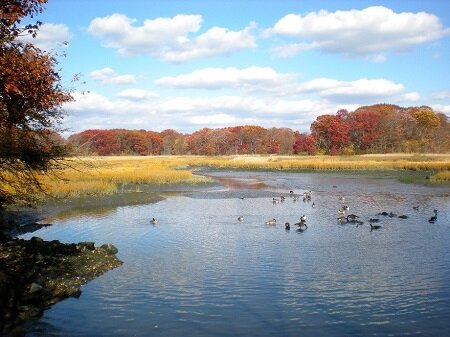Water and Wetlands
Pelham Bay Park’s 13-mile shoreline is one of its most distinctive features, offering sublime vistas for the hiker and vital habitat for abundant wildlife species. The dominant surrounding waters of Long Island Sound shape the park’s coastal environment and provide warm sunbathing in the summer at Orchard Beach. The Hutchinson River forms the park’s western border, while Eastchester Bay serves as a division between Rodman’s Neck and the southern area of the Park. The picturesque Lagoon flows between the area of Orchard Beach/Hunter Island and the woodlands where Bartow-Pell Mansion sits. Bartow Creek, Goose Creek, and Turtle Cove offer additional opportunities for being close to the water.
The Lagoon
When Orchard Beach was built between 1934 and 1938, the original “Pelham Bay” was filled in. The remaining waterway west of the parking lot became known as The Lagoon. In the early 1960s, The Lagoon was widened and dredged to host the 1964 U.S. Olympic Rowing Trials.
The open water is a little‑disturbed environment where fish are plentiful. Fluke, Winter Flounder, and Bluefish run here during their respective seasons. The calm waters, abundant marine life, and thriving salt marsh attract many varieties of birds, such as the American Black Duck which is abundant in winter. Wading birds, such as Egrets and Herons, and shorebirds, such as Willets and Killdeer, are found here while migrating Ospreys can be seen plunging into the water to catch fish. The Lagoon is also a popular spot for rowing crews from local schools. Park visitors can use the canoe and kayak launch located in the northwest corner of the Orchard Beach parking lot.
Image: The Lagoon, Looking North taken by Marianne Anderson, NYC Parks & Recreation
Turtle Cove
Turtle Cove is an inlet from Eastchester Bay that is located between the Turtle Cove Golf Center on City Island Road and Park Drive (leading to Orchard Beach). The Cove’s habitat has been severely impacted by human intervention. Early in the 20th century, a berm was created across the Cove to establish a rail line to carry horsecars. That berm created a barrier isolating the northern section of the Cove and causing it to become a freshwater habitat. A culvert was placed across the berm to allow saltwater to flow through, but it was often clogged and ineffectual. In 2009, Parks began a restoration project to improve the ecosystem by removing non-native invasive trees and vines and create a more vibrant salt marsh. The MillionTreesNY initiative planted thousands of new trees and shrubs in surrounding uplands and the Friends of Pelham Bay Park helped plant saltmarsh grass in the northern cove. The berm was breached to increase tidal flow and a footbridge constructed to re-establish foot traffic along the Siwanoy Trail. Herons and egrets are a common sight.
Image: NYC Parks
Wetlands
Pelham Bay Park contains both freshwater and saltwater wetlands – invaluable ecosystems that are vital to both humans and wildlife. Wetlands serve a vital role as natural filtration systems. Their self‑cleansing ability and capacity to trap pollutants help improve water quality. Wetlands reduce flooding and erosion and improve air quality by absorbing carbon dioxide and producing oxygen.
At one time, about half of present-day New York City was wetland – both freshwater and saltwater. As the growing metropolis demanded more space, wetlands, thought to be little more than breeding grounds for pests, were filled with debris and developed. Areas once crossed with freshwater creeks and dotted with ponds have been paved over, their waters diverted into culverts and sewers.
Image: Goose Creek Marsh taken by Marianne Anderson, NYC Parks & Recreation
Saltwater Wetlands
Indigenous people stayed in the area now known as Pelham Bay Park during the warm seasons – fishing, collecting shellfish, hunting, and gathering plants along the inlets. When Europeans arrived, they did some of the same, even harvesting the salt grasses to use as feed for their farm animals in the lean winter months.
Pelham Bay Park is home to one of New York City’s largest areas of tidal wetlands, 195 acres of salt marsh that provides migrant shorebirds with a place to rest, feed, and breed. The park’s three major marshes – fed by Goose Creek, the Hutchinson River, and the Lagoon – provide salt grasses that are submerged in shallow water part or all of the time, and during low tides, fertile mudflats are exposed. The marshes are a habitat for a variety of wildlife, including herons, egrets, gulls, hawks, and raccoons. A good viewing spot is from the footbridge in Turtle Cove. Salt marshes can also be found on the coast of Hunter Island by hiking along the Kazimiroff Nature Trail.
Freshwater Wetlands
Freshwater wetlands sustain a great number of plants and animals and are influenced by the characteristics of the land beneath them. Soil composition determines a site’s water-holding capabilities and the position of the groundwater table under the soil surface determines if water levels above ground remain relatively constant or dry up quickly.
In Pelham Bay Park, a few small ponds are lined by thick-stemmed plants like Cattail and Arrow Alum. Wet meadows in the park, which can be found south of Orchard Beach, have interesting plants like Bulrush and Joe-Pye weed. More often in Pelham, wet or moist forests of Red Maple, Sweetgum, and Pin Oak abound. A hike through the Central Woodlands west of Turtle Cove Golf Center or a bike or horse ride north of the golf courses are wonderful sites for wet woods.



